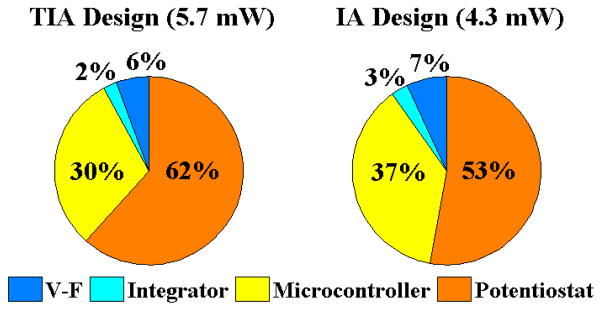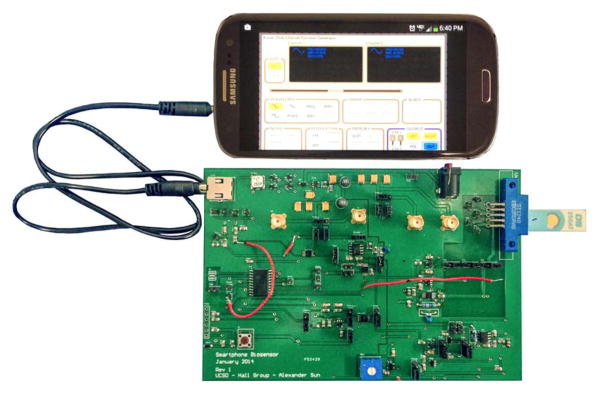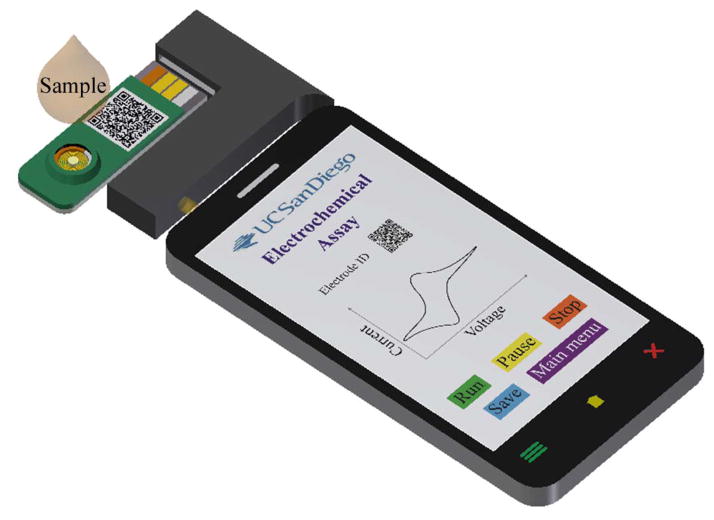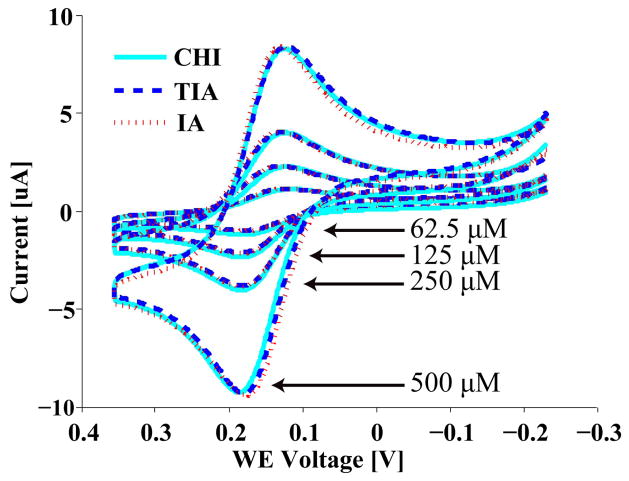Abstract
This paper describes the development of a smartphone-based electrochemical biosensor module. The module contains a low power potentiostat that interfaces and harvests power from a smartphone through the phone’s audio jack. A prototype with two different potentiostat designs was constructed and used to conduct proof of concept cyclic voltammetry experiments with potassium ferro-/ferricyanide (K4[Fe(CN)6] / K3[Fe(CN)6]) in a side-by-side comparison with a laboratory grade instrument. Results show that the module functions within the available power budget and that the recovered voltammogram data matches well with the data from an expensive bench top tool. Excluding the loses from supply rectification and regulation, the module consumes either 5.7 mW or 4.3 mW peak power, depending on which of the two discussed potentiostat designs is used. At single quantity pricing, the hardware for the prototype device costs less than $30.
I. Introduction
Currently, there are approximately 1.75 billion smartphone users worldwide, with an estimated growth to 2.03 billion (28% of the world’s population) by 2015 [1]. This wide spread availability of mobile computing has inspired a surge of peripheral devices that add functionality to the smartphone. By leveraging the processing power and connectivity available on the smartphone, complex yet portable systems can be developed that are oftentimes more accessible and cost-effective than specialized devices. Examples include the Square® credit card reader dongle, the iBGStar® blood glucose meter, and the AliveCor® ECG monitor. Perhaps one of the most desirable and compelling peripheral devices would be a portable molecular sensor for medical diagnosis, augmenting or replacing bulky equipment usually confined to centralized labs. Such a device would enable numerous point-of-care (POC) applications allowing individuals to run simple medical tests without visiting a lab or doctor’s office, thereby improving the convenience and speed of medical diagnoses.
In this paper, we outline the development of a module for a low-cost smartphone based biosensor (Fig. 1). The module plugs directly into the user’s smartphone through the audio jack and interfaces with disposable screen printed electrodes (SPE) that can be functionalized with different detection molecules such as antibodies or nucleic acids. The user would then be able to run the diagnostic test with an on-phone app capable of securely transmitting the results to data-storage-and-analysis platforms such as UCSD’s KEEP [2]. The device contains a potentiostat, which is used to conduct electrochemical experiments and run assays to detect and quantify biomarkers. Traditionally, potentiostats are expensive pieces of specialized laboratory equipment ranging in price from $1,000 to $10,000. Although low cost potentiostats have been developed in the past [3], [4], this module is unique in that it leverages the smartphone for its computational power, wireless connectivity, battery, display, and audio recording and playback channels. Furthermore, since the module uses the standard 3.5 mm audio jack as an interface rather than USB or a proprietary port, the same hardware can be used with all phones. As a result, this module requires minimal parts and is compatible with virtually all smartphones.
Fig. 1.
3-D rendered prototype of proposed system.
II. Design of the Electronic Module
The 3.5 mm audio interface has four connections: the left and right audio channels, microphone input and common. This design uses the left channel to deliver power, the right channel to send instructions from the phone, and the microphone input to send data back to the phone. However, each port is AC coupled, preventing the module from directly tapping into the phone’s DC power and transmitting the low frequency signals typical of standard electrochemical experiments such as cyclic voltammetry (CV). Therefore, the electronic module must create its own DC power harvested from an audio band tone in the 20 Hz–22 kHz range generated by the phone and transmit data to and from the phone using modulated audio signals.
The electronic module has four main functional blocks: the power harvester, controller, potentiostat, and voltage to frequency converter. The power harvester, using the topology from the University of Michigan’s Project Hijack, rectifies a 22 kHz tone on the left audio channel and creates a regulated power supply [5]. The potentiostat runs the electrochemical experiments by controlling the potential between electrodes within the biological sample under test and measuring the resulting current. The control block uses a microcontroller and integrator to generate the voltage waveform for the potentiostat. The communication block converts the voltage data from the potentiostat into frequency information through a voltage controlled oscillator (VCO), which is sent to the phone through the microphone input, along with periodic marker tones from the microcontroller for reconstruction and synchronization on the phone. The design of each block will be discussed in the following sections.
A. Power
The power harvester uses a 1:20 turn ratio transformer to step up the low voltage tone from the phone. The tone is rectified by a MOSFET H-Bridge and passed through a Schottky diode. This topology has been shown to achieve an efficiency of approximately 50% [5]. The rectified voltage is then regulated to 4 V for the system. While more efficient rectification schemes will be investigated in the future, this paper will define power as that measured after the regulator in this topology. The available power delivered to the device depends on the phone model being used. According to previous studies on a number of popular smartphones, the available power varies between 5–10 mW [6]. Since the performance of the potentiostat determines the baseline sensitivity of the system, a large portion of the power budget was allocated for the potentiostat block. Most of the other active components were chosen to minimize power consumption.
B. Potentiostat
The potentiostat sets the voltage between the working electrode (WE) and the reference electrode (RE) in the sample under test, by providing the necessary current through the counter electrode (CE). When running a CV measurement, as shown in Fig. 2, the potentiostat slowly ramps the WE potential up and down. This potential sweep induces redox reactions at the WE and generates a current signal. This current is traditionally measured with a transimpedance amplifier (TIA) [7], [8], but in this paper we also study another topology that uses an instrumentation amplifier (IA) [9]. One main advantage of the IA topology is that the common-mode potential of the amplifier can be set independently of the WE potential. For experiments where either the cathodic or anodic current is larger than the other, the common-mode voltage level can be shifted to increase the output headroom. For the same input bias current (10 pA), the IA topology consumes less power than the TIA based design, but at the cost of higher noise with a measured input-referred integrated noise for a 10 kHz bandwidth of 429 pArms versus 26.7 pArms for the TIA design. Therefore, in cases where the sensitivity of the biosensor is not as crucial, this design would be an acceptable low-power alternative. These topologies will be referred to as the TIA and IA designs. Both are designed to measure a bidirectional current from 100 pA to 10 μA.
Fig. 2.
Simplified system schematic: The power harvester (a) transforms, rectifies, and regulates a tone from the phone to a 4 V supply. The microcontroller (b1) receives a trigger from the phone and uses the integrator (b2) to send a voltage waveform to the potentiostat (c), which runs the experiment. The voltage to frequency converter (d) converts the resulting output to a frequency to be transmitted back to the phone.
For standard CV, the working electrode potential is first held constant and then slowly ramped with a scan rate typically on the order of 10–100 mV/s. This speed results in a triangular voltage waveform with a period of several seconds. Due to the AC coupling on the audio jack, this waveform cannot be generated directly from the phone. Instead, an op-amp integrator is used to integrate the DC component of a PWM signal generated by the microcontroller and produce the required voltage waveform. Using this topology, the voltage ramps can be generated by PWM signals with a constant duty cycle, while the constant bias voltages can be created from PWM signals toggled between two different duty cycles. This approach keeps the computational burden on the microcontroller low during the ramping in CV, thereby reducing power consumption. Freeing up clock cycles also allows the microcontroller to correct for drift error during an experiment. To perform this correction, the microcontroller samples the output of the integrator to detect when the voltage surpasses a threshold and reverses the voltage direction accordingly.
The only requirements imposed on the microcontroller by the potentiostat is the ability to generate PWM signals and an ADC to keep track of the integrator output with coarse accuracy. Hence, this design uses a microcontroller with an adjustable internal oscillator and 10-bit ADC. With a 4 volt supply rail, this gives us approximately 4 mV of resolution on the integrator. With the slow scan rate, the clock frequency of the microcontroller can be set quite low, at 500 kHz to keep power consumption to a minimum.
C. Communication
In the data return link, the signal between the potentiostat and phone is kept in the analog domain. This allows us to use the higher resolution ADC of the phone to digitize the data. To get the low frequency voltage signals from the potentiostat past the DC blocking capacitors, the voltage is mapped to audio band frequency information using a 555 timer voltage controlled oscillator. The 555 timer uses an external RC network to generate timing events for an SR latch using two comparators and a discharge transistor. The oscillator has a 2 V linear input range centered near mid-supply and an output frequency range of 4.3–8.1 kHz. After attenuating the output, it is sent to the phone through the microphone port. The frequency range is chosen to be within the 22 kHz audio bandwidth so that the standard audio recorder Nyquist rate of 44.1 kHz can capture the signal. The original current data is then recovered by taking the FFT of the data stream in 100 ms windows and using the VCO and transimpedance or instrumentation amplifier gains. Currently, a PC is used to analyze the data and perform frequency to current conversion. However, once we move to using an on-phone app for collection and analysis, we will explore other more efficient algorithms to recover the data.
In order to generate the voltammogram accurately, the output current time waveform must be mapped back to the input voltage ramp. To facilitate this, the microcontroller shuts off the output of the VCO and sends a brief 1 kHz tone to the phone at predetermined points in the test. These 100 ms spurs occur every time the microcontroller detects a peak at the output of the integrator and at the start and end of every test. When constructing the voltammogram, the algorithm looks for these marker tones to identify the transition points in the data. Furthermore, since these tones occur at the voltage transitions and away from the anodic and cathodic current peaks, no crucial information is lost by periodically interrupting the data stream with these short marker tones.
With proper sizing of passive components, this VCO implementation offers lower power consumption compared to other integrated solutions. For example, while the AD7740 from Analog Devices offers a wider linear range than the 555 timer, it requires a clock. Generating this clock places extra burden on the microcontroller and becomes difficult to do as the system clock slows down to reduce power consumption. Although the AD7740 is included on our test board, all subsequent tests use the 555 timer circuit as previously described.
III. Measured Performance
A prototype of the electronic module was implemented on a PCB, which was designed to allow the testing of each individual block separately and swap in different block designs for the potentiostat and communication circuitry. For the microcontroller we used the PIC16F685 from Microchip Technology Inc., which has the PWM and 10-bit ADC functionality required. The 555 timer is the low power ICM7555 CMOS variant from NXP Semiconductors. In single quantity, the cost of the parts for a module is less than $30.
A. Power Measurements
To ensure that the entire system could be powered by using a smartphone, we tested both an Apple iPhone 5s and a Samsung Galaxy S3 by connecting them to our electronic module via the audio port and playing a 22 kHz tone. By sweeping a variable load attached to the output of the power harvester block, a maximum attainable power of 7 mW and 4.4 mW was measured from after the low-dropout (LDO) regulator for the iPhone 5s and Galaxy S3 respectively. These phone models are a good representation of the range of power expected from different types of smartphones.
Fig. 5 shows the power consumption of each block measured with the Keithley 2406b Source Meter bypassing the regulator and providing 4 V to the system. As expected, the dominant sources of consumption are the potentiostat and the microcontroller. A full system test demonstrates that the module with the TIA potentiostat consumes a total of 5.7 mW, which fits well within the power budget of the iPhone 5s, while the device with the IA design consumes 4.3 mW, which can run off the power from the Samsung S3 phone.
Fig. 5.

System power usage per block for both TIA and IA potentiostat designs.
B. Chemical Measurements
Cyclic voltammetry experiments were conducted using an equal mixture of potassium ferrocyanide (K4[Fe(CN)6]) and potassium ferricyanide (K3[Fe(CN)6]) from Spectrum (P1286, P1296) in a phosphate buffer solution of 150 mM potassium phosphate monobasic from Fischer Scientific (P285-500) and potassium phosphate dibasic from EMD Millipore (PX1570-1). The electronic module was connected to the audio port of a PC, which triggers the start of the electrochemical test via the right audio channel and records the audio data from the module. Samples of 62.5 μM, 125 μM, 250 μM, and 500 μM K4[Fe(CN)6] / K3[Fe(CN)6] were applied to gold SPEs from DropSens. Cyclic voltammetry was run on both the complete electronic module and the 750E potentiostat from CH Instruments, Inc. Figure 6 shows the voltammograms generated by the TIA and IA potentiostat designs overlaid with the results from the CHI. The voltammograms from both the TIA and IA design match well with those of the CHI given that variations will occur due to changes in the sample over time.
Fig. 6.
Comparison between CHI potentiostat and both smartphone potentiostat designs. CVs of several K4[Fe(CN)6]/ K3[Fe(CN)6] dilutions were run with a 10 mV/s scan rate and 1,400 samples per sweep.
IV. Conclusions and Future Work
We have implemented a smartphone-based electrochemical biosensor that uses the audio jack on a smartphone for both communication and power. The prototype is within the power budget of commercially available smartphones. The device has been used to conduct cyclic voltammetry measurements and the resulting voltammograms match well with those measured from a table top potentiostat. Eventually, a smartphone app will be created that can communicate with the module, sending it test parameters and analyzing the data received. On the biochemistry side, inexpensive methods to functionalize SPE electrodes for biosensing are currently being investigated, and a complete electrochemical assay will eventually be run on the module. To reduce the power consumption of the device, more efficient power rectification schemes will be explored and a lower power microcontroller will be used. Additionally, more functionality will be added to be able to create different voltage waveforms to run a range of electrochemical experiments. Finally, since, in the past, integrated switch capacitor based potentiostats [8], [10] have been shown to have vastly reduced power and area, we will explore the design of an integrated circuit solution for the read-out circuitry.
Fig. 3.

Potentiostat designs with TIA (left) and IA (right).
Fig. 4.

Photograph of prototype board powered by a Samsung Galaxy S3.
Acknowledgments
This work was supported by Intel under contract 2441.001 and CTRI under grant UL1TR000100.
The authors would like to thank members of the Integrated Biosensors Laboratory at Intel Labs for useful discussions.
References
- 1. [Accessed: 30-May-2014];Smartphone Users Worldwide Will Total 1.75 Billion in 2014. [Online]. Available: http://www.emarketer.com/Article/Smartphone-Users-Worldwide-Will-Total-175-Billion-2014/1010536.
- 2. [Accessed: 31-May-2014];Distributed Health Open Health Stack. [Online]. Available: http://dhlabs.calit2.net/open-health-stack/
- 3.Rowe AA, Bonham AJ, White RJ, Zimmer MP, Yadgar RJ, Hobza TM, Honea JW, Ben-Yaacov I, Plaxco KW. CheapStat: An Open-Source, ‘Do-It-Yourself’ Potentiostat for Analytical and Educational Applications. PLoS ONE. 2011 Sep;6(9):e23783. doi: 10.1371/journal.pone.0023783. [DOI] [PMC free article] [PubMed] [Google Scholar]
- 4.Lillehoj PB, Huang MC, Truong N, Ho CM. Rapid electrochemical detection on a mobile phone. Lab Chip. 2013 Jul;13(15):2950–2955. doi: 10.1039/c3lc50306b. [DOI] [PubMed] [Google Scholar]
- 5.Kuo Y-S, Schmid T, Dutta P. Hijacking power and bandwidth from the mobile phone’s audio interface. Proc Int Symp Low Power Electron Des. 2010 [Google Scholar]
- 6.Silicon Labs, Appl. Note AN0054
- 7.Bard Allen J. Electrochemical Methods Fundamentals and Applications. 2. Wiley; 2001. Electrochemical Instrumentation; pp. 632–658. [Google Scholar]
- 8.Bandyopadhyay A, Mulliken G, Cauwenberghs G, Thakor N. VLSI potentiostat array for distributed electrochemical neural recording. IEEE International Symposium on Circuits and Systems, 2002. ISCAS 2002; 2002. pp. II–740–II–743. [Google Scholar]
- 9.Busoni L, Carlà M, Lanzi L. A comparison between potentiostatic circuits with grounded work or auxiliary electrode. Rev Sci Instrum. 2002 Apr;73(4):1921. [Google Scholar]
- 10.Nazari MH, Mazhab-Jafari H, Leng L, Guenther A, Genov R. CMOS Neurotransmitter Microarray: 96-Channel Integrated Potentiostat With On-Die Microsensors. IEEE Trans Biomed Circuits Syst. 2013 Jun;7(3):338–348. doi: 10.1109/TBCAS.2012.2203597. [DOI] [PubMed] [Google Scholar]





